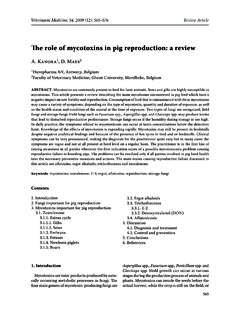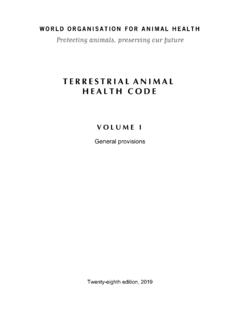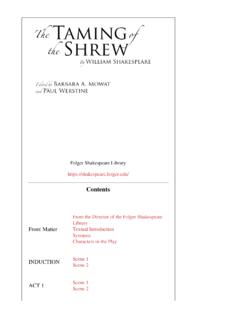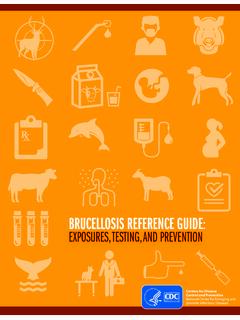Transcription of Effects of bromelain supplementation on growth …
1 544 Original Paper Veterinarni Medicina, 60, 2015 (10): 544 552doi: of bromelain supplementation on growth performance , nutrient digestibility, blood profiles, faecal microbial shedding, faecal score and faecal noxious gas emission in weanling Hossain, Lee, KimDepartment of Animal Resource and Science, Dankook University, Cheonan, Choongnam, Republic of KoreaABSTRACT: A total of 140 weanling pigs [(Yorkshire Landrace) Duroc] with an average body weight ( ) of kg were used in a six-week trial. Pigs were randomly allotted to one of four experimental treatments according to their initial (seven pens per treatment with five pigs per pen). Dietary treatments were: CON = control diet, T1 = CON + bromelain , T2 = CON + bromelain , T3 = CON + bromelain .
2 The experiment was divided into two phases (Days 1 to 14 and Days 15 to 42). All diets, in mash form, were formulated to meet or exceed the nutrient requirements (NRC, 2012) for weanling pigs. Feed intake and were monitored at the end of each phase. T3 treatment had greater (342 vs. 305 g; 409 vs. 387 g; P < ) average daily gain (ADG) and average daily feed intake (ADFI) than CON treatment in Phase 1. In Phase 2, the ADG was improved (from T1 to T3: 612, 616, 637 vs. 583 g; P < ) in all bromelain treatments compared with CON treatment, ADFI and growth efficiency (G : F) ratio of T3 treatment were higher (833 vs. 803 g; vs. g; P < ) compared with CON treatment. Overall, T3 treatment showed greater (539 vs.)
3 490 g; 691 vs. 664 g; P < ) ADG and ADFI than CON. Moreover, pigs fed bromelain diets exhibited increased ( , , vs. ; P < ) G : F ratios compared with those fed CON diet. Pigs fed bromelain diets exhibited increased (two weeks: , , vs. ; , , vs. ; six weeks: , , vs. %; , , vs. ; P < ) apparent total tract digestibility (ATTD) of dry matter and nitrogen compared with those fed CON diet at Week 2 and Week 6. On Day 42, the blood creatinine in the CON group was higher ( vs. , , mg/dl; P < ) compared with the bromelain treatment groups. Faecal E. coli counts were decreased ( vs. log10 cfu/g; P < ) in T2 treatment compared with CON treatment. The faecal ammonia (NH3) gas emission in T2 and T3 treatments decreased ( , vs.
4 Ppm; P < ) compared with CON. In conclusion, dietary supplementation with bromelain has here been shown to improve the growth performance , apparent total tract digestibility of dry matter and N and to decrease E. coli and faecal NH3 gas emission in weanling : apparent total tract digestibility; blood creatinine; E. coli; NH3 gas emissionList of abbreviationsADFI = average daily feed intake, ADG = average daily gain, AT T D = apparent total tract digestibility, DM = dry matter, G : F = growth efficiency, NH3 = ammoniaAntibiotic supplementation is well accepted to improve growth and efficiency in swine (Hahn et al. 2006). However, repeated use of antibiotics in animal diets results in severe problems like resist-ance of pathogens to antibiotics, accumulation of antibiotic residues in animal products and the envi-ronment, imbalance of normal microflora, and re-duction in beneficial intestinal microflora (Hinton et al.
5 1986; Barton 2000). This has resulted in a se-vere restriction or total ban on the use of antibiotics 545 Veterinarni Medicina, 60, 2015 (10): 544 552 Original Paperdoi: the animal and poultry industry in many coun-tries, which in turn has led to a growing interest in alternatives to antibiotic growth promoters such as enzymes, oligosaccharides, herbs, flavours, miner-als and non-starch polysaccharides (Close 2000). Pineapple (Ananas comosus) is the leading edible member of the family Bromeliaceae, grown in sev-eral tropical and subtropical countries including Philippines, Thailand, Indonesia, Malaysia, Kenya, India and China. It has been used as a medicinal plant in several native cultures (Mondal et al.
6 2011) and these medicinal qualities of pineapple are at-tributed to bromelain . bromelain is an aqueous extract of pineapple that contains a complex mix-ture of thiol proteases and non-protease compo-nents. Proteases constitute the major components of bromelain and include stem bromelain (80%), fruit bromelain (10%) and ananain (5%). Among non-protease components number phosphatases, glucosidases, peroxidases, cellulases, glycoproteins and carbohydrates (Maurer 2001). Assays for the individual protease components of bromelain have recently been established thus raising the possibil-ity of standardising bromelain preparations (Hale et al. 2005). bromelain offers a wide range of therapeutic ben-efits and is increasingly being accepted as a phy-totherapeutical drug (Maurer 2001).
7 Similar to the model plant cysteine protease papain, bromelain is remarkably heat stable, retaining proteolytic activ-ity between 40 C and 60 C where most enzymes are destroyed or denatured. The optimal tempera-ture for the proteolysis of stem bromelain ranged from 35 50 C in one study (Greenberg 1955), and up to 60 C in later studies (Natalucci et al. 1985). bromelain , unlike most enzymes, has a very wide effective range of activity in both acidic and alkaline conditions that allows it to remain active in a vari-ety of biological environments. It is stable between pH and and is of broad specificity (Minami et al. 1971). This enzyme is a good alternative to microbial proteases like subtilisins from Bacillus li-cheniformis and Bacillus amyloliquifaceins that are enzymes of choice for detergents (Van Beckhoven et al.)
8 1995). However, the effect of bromelain on weanling pigs has not been studied yet. Therefore, the aim of the present study was to evaluate the Effects of bromelain supplementation on growth performance , nutrient digestibility, blood profiles, faecal microbial shedding, faecal score and faecal noxious gas emission in weanling AND METHODSThe Animal Care and Use Committee of Dankook University approved the experimental procedures used in this and experimental design. A total of 140 weanling pigs [(Yorkshire Landrace) Duroc] with an average body weight ( ) of kg were used in a six-week experiment. Pigs were randomly allotted to one of four experimental diets according to initial There were seven replicate pens per treatment with five pigs (two gilts and three borrows) per pen.
9 All pigs were housed in an environmentally-controlled room, which provided m2 for each pig. Each pen was equipped with a one-sided, stainless steel self-feeder and a nipple drinker that allowed access to feed and water ad libitum. Dietary treatments were: CON = control diet; T1 = CON + bromelain ; T2 = CON + bromelain ; T3 = CON + bromelain . The experiment in-cluded two phases: Days 1 to 14 and Days 15 to 42 (Table 1). All nutrients in diets were formulated to meet or exceed the recommendations of NRC (2012) for weanling pigs and fed in a mash form. bromelain (Pinex ) as powder form was supplied by EunjinBio, Cheonan, South Korea and added to the basal diet at percentages of , and and measurements.
10 Individual pig and feed disappearance were recorded on Days 14 and 42 to calculate average daily gain (ADG), average daily feed intake (ADFI) and feed efficiency (G : F). All pigs were fed diets mixed with chromium oxide (Cr2O3) as an indigestible marker during Days 8 to 14 and Days 36 to 42. Fresh faecal grab samples were collected from two pigs per pen (Days 12 to 14 and Days 40 to 42) via rectal massage. Representative samples were stored in a freezer at 20 C until an-alysed (Fenton and Fenton 1979). Before chemical analysis, the faecal samples were thawed and dried at 60 C for 72 h, after which they were finely ground to a size that could pass through a 1-mm screen. The procedures utilised for the determination of dry mat-ter (DM), nitrogen (N) and energy (E) digestibilities were conducted in accordance with the methods es-tablished by the AOAC (1995).












